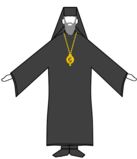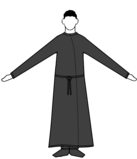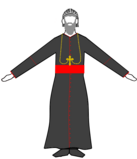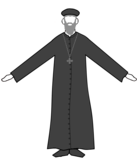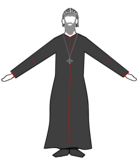Cassock
This article needs additional citations for verification. (November 2022) |
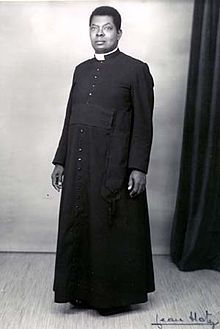
| Part of a series on |
| Western dress codes and corresponding attires |
|---|
|
Legend:
Contents/Culture and the arts portal |
The cassock or soutane is a
The cassock derives historically from the tunic of classical antiquity that in ancient Rome was worn underneath the toga, and the chiton that was worn beneath the himation in ancient Greece. In religious services, it has traditionally been worn underneath vestments, such as the alb.
In the West, the cassock is little used today except for religious services, save for traditionalist and those other Catholic clergy and religious who continue to wear the cassock as their standard attire. However, in many countries it was the normal everyday wear of the clergy until the 1960s, when it was largely replaced by clerical suits, distinguished from lay dress by being generally black and by a black shirt incorporating a clerical collar.
In
Etymology
The word cassock comes from
The word soutane is a French word, coming from Latin subtana, the adjectival form of subtus (beneath).[3]
Western Christian practice
Latin Catholic



The cassock (or soutane) comes in a number of styles or
The ordinary Roman cassock worn by Roman Catholic clerics (as distinct from that worn as choir dress) is black except in
The 1969 Instruction on the dress of prelates stated that for all of them, even cardinals, the dress for ordinary use may be a simple black cassock without coloured trim.[5]
A band cincture or sash, known also as a
In choir dress, chaplains of His Holiness wear their purple-trimmed black cassocks with a cotta, but bishops, protonotaries apostolic, and honorary prelates use (with a cotta or, in the case of bishops, a rochet and mozzetta) cassocks that are fully purple (this purple corresponds more closely with a Roman purple and is approximated as fuchsia) with scarlet trim, while those of cardinals are fully scarlet with scarlet trim. Cardinals have the additional distinction of having both choir cassock sleeves and the fascia made of scarlet watered-silk. The cut of the choir cassock is still a Roman-cut or French-cut Roman cassock.
In the past, a cardinal's cassock was made entirely of watered silk, with a train that could be fastened at the back of the cassock. This train was abolished by the motu proprio Valde solliciti of Pope Pius XII with effect from 1 January 1953.[7] With the same motu proprio, the Pope ordered that the violet cassock (then used in penitential periods and in mourning) be made of wool, not silk,[8] and in February 1965, under Pope Paul VI, a circular of the Sacred Ceremonial Congregation abolished the use of watered silk also for the red cassock.[9]
An elbow-length shoulder cape, open in front, is sometimes worn with the cassock, either fixed to it or detachable. It is known as a pellegrina. It is distinct from the mozzetta, which is buttoned in front and is worn over a rochet.
The general rule of the Roman Catholic Church is that the pellegrina may be worn with the cassock by cardinals and bishops.[10] In 1850, the year in which he restored the Catholic hierarchy in England and Wales, Pope Pius IX was understood to grant to all priests there the privilege of wearing a replica in black of his own white caped cassock.[11] Since then, the wearing of the pellegrina with the cassock has been a sign of a Roman Catholic priest in England and Wales, Scotland, Ireland, Australia, and New Zealand, although sometimes imitated by Anglican priests.
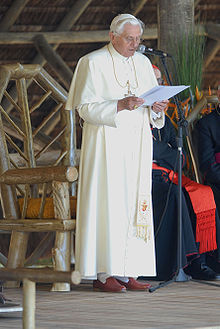
In his 1909 book, Costume of Prelates of the Catholic Church, John Abel Felix Prosper Nainfa proposed[12] the use of the English word "simar", instead of the word "cassock", for the garment with shoulder cape, which he treated as distinct from the cassock proper. Others too have made the same distinction between the "simar" (with pellegrina) and the "cassock" (without), but many scholars disagree with Nainfa's distinction.[13] More particularly, documents of the Holy See make no such distinction, using the term cassock or vestis talaris whether a pellegrina is attached or is not. Thus the 1969 instruction states that, for cardinals and bishops, "the elbow-length cape, trimmed in the same manner as this cassock, may be worn over it".[10] Cassock, rather than simar, is the term that is usually applied to the dress of Popes and other Catholic ecclesiastics. The instruction also gives no support to Nainfa's claim that the cassock with shoulder cape should not be worn in church services, which moreover would be of difficult application, since the cassock with pellegrina is generally made as a single garment, with a non-detachable pellegrina.
Nainfa wrote that at that time the garment with shoulder cape was in Italian called a zimarra, a term, however, that in that language is today used rather of a historical loose-fitting overgown, quite unlike the close-fitting cassock with pellegrina worn by Catholic clergy,[14][15] and similar to the fur-lined Schaube [de] that was used in northern Europe.[16][17] Images of the historical zimarra as worn by women can be seen at "Dressing the Italian Way"[18] and "The Italian Showcase".[19]
In cold weather, the manto, an ankle-length cape with or without shoulder cape, or the greca, also known as the douillette, an ankle-length double-breasted overcoat, is traditionally worn over the cassock. For bishops and priests both the manto and greca are solid black in colour, while for the pope the manto is red and the greca is white.
-
Cardinal
(Often with pellegrina.) -
Bishop
(Often with pellegrina.)
(Also worn by Protonotaries Apostolic
and Honorary Prelates, but without
pellegrina and zucchetto.) -
Chaplain
of His Holiness -
Priest/Deacon/
Seminarian
Anglican and Methodist

The Anglican church uses single and double-breasted cassocks. For many this is to indicate tradition (single-breasted in the Anglo-Catholic tradition and double-breasted in the evangelical end of the church).
The double-breasted cassock fastens at the shoulders on the opposing side of the breast and at the waist with one concealed button. The latter usually has a single small stem-button sewn at centre front about 12–15 centimetres (4+1⁄2–6 in) below the centre-front neck line which is used to secure the
The single-breasted cassock worn by Anglicans traditionally has thirty-nine buttons as signifying the
Cassocks are often worn without a cincture and some opt for a buckled belt.[20]
Black is the most common colour for priests (

Cassocks are sometimes also worn by
Ministers (presbyters) of the Methodist Church of Great Britain also traditionally wear a double-breasted cassock (as in the evangelical Anglican tradition).[23]
-
Bishop
-
Canon
(cassock colour may vary) -
Presbyter/Deacon/Layperson
cassock colour may vary if worn
by, for instance, a chorister
Lutheran
In the Evangelical Lutheran Churches of
The Cassock is also worn occasionally in American Lutheran churches. In previous years, the cassock was worn in combination with a white surplice which almost entirely covered it. It is customary for a minority of clergy to wear it on special high holidays such as Good Friday and Ash Wednesday. Most commonly, Lutheran pastors wear an
Presbyterian
In the
Presbyterians in Canada tend to follow the custom of the Church of Scotland, whereas Presbyterians in the United States typically wear an American Geneva gown over a sleeveless cassock or a non-cuffed gown over an Anglican or Roman style cassock. The American
As is the practice in the Anglican churches, cassocks may be worn by others who are not ministers. Ordained elders and deacons, as they serve as worship leaders, readers, and administer communion may also wear cassocks which tend to be black. Those worn by choirs and other worship leaders are usually coloured (for instance, The Shadyside Presbyterian Church (U.S.A.) choir is dressed in red cassocks under white surplices).
Eastern Christian practice
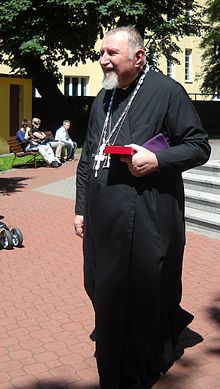
In Eastern Christianity there are two types of cassock: the Inner Cassock and the Outer Cassock or Rason. Monastics always wear a black cassock. There is no rule about colouration for non-monastic clergy, but black is the most common. Blue or grey are also seen frequently, while white is sometimes worn for Pascha. In the Eastern Churches, cassocks are not dress for any lay ministry. Generally, one has to be blessed to wear a cassock usually in the case of exercising a clerical duty.
Types of Eastern cassocks
- The inner cassock (more often simply cassock) is an ankle length garment worn by all major and minor clergy, monastics, and often by male seminarians. The Slavic, or "Russian" style (Russian: подрясник podryasnik, Ukrainian: підрясник pidryasnyk) is double-breasted, closely fitted through the torso and flaring out to the skirt, with a high collar buttoned off-center, and may be cinctured with either a leather or wide cloth belt.[24] The Greek version, called an anteri (αντερί), rason (ράσον), or zostiko (ζωστικό) is somewhat fuller, gathered at the waist with a narrow cloth belt, and with a high collar buttoned in the front.[25] The inner cassock is usually worn by all clergy members under their liturgical vestments.
- The outer cassock (Ancient Greek: εξώρασον, ράσον exorason) is a voluminous garment worn over the inner cassock by bishops, priests, deacons, and monastics as their regular outerwear.[26] It is not worn by seminarians, readers or subdeacons in the Russian tradition. In the Greek tradition, however, chanters may wear it in church, usually with no inner cassock beneath but directly over secular clothing. The outer cassock should be worn by a priest celebrating a service such as Vespers where the rubrics call for him to be less than fully vested, but it is not worn by any clergy beneath the sticharion. It may be worn with the bottoms of the sleeves turned back, which are sometimes faced in a contrasting colour. The Greek version tends to be somewhat lighter weight and more fully cut than the Russian. It is originally a monastic garment, and in the Russian tradition a man must be explicitly blessed by the bishop to wear it following his ordination to the diaconate.
- A cassock vest ("kontorasson" (κοντόρασον), "amaniko" (αμάνικο), "gileko" (γιλέκο)) is sometimes worn over the inner cassock. This is a closely fitted collarless
- A cassock coat may be worn on very cold days, with the same cut as the outer cassock but slightly larger and of heavier material. It may or may not have a fur-lined collar.[29] The coat is worn over the outer cassock, although many clerics may wear it in lieu of a coat on colder days.
Eastern Catholic and Orthodox examples
-
Bishop
-
Priest with grey Zostikon, a
Kontorasson, and a Skufia. -
Priest (married)
-
Hieromonk (celibate Priest)
-
Monk
-
Chanter/Subdeacon/Deacon
dressed in the Zostikon
Oriental Orthodox examples
-
Syriac Patriarch
-
Syriac Bishop
-
Coptic Priest
-
Syriac Priest
-
Coptic & Syriac Priest
(monk)
Non-clerical 17th-century garment
The term cassock can also refer to a loose-fitting, pullover, hip-length jacket worn by ordinary soldiers in the 17th century.[citation needed] A cassock has attached sleeves and is open down the sides, similar to a mandilion. Such garments are popularly recognized as the formal uniform of the Musketeers of the Guard in The Three Musketeers – though this is suspect historically.
References
- ^ Online Etymology Dictionary and American Heritage Dictionary of the English Language. Retrieved 14 March 2010.
- ^ "Decency in Apparel enjoined to Ministers". Constitutions and Canons Ecclesiastical Of the Church of England.
- ^ "Collins English Dictionary". Collins English Dictionary. Retrieved 25 August 2014.
- ^ "Instruction on the Dress, Titles and Coats-of-Arms of Cardinals, Bishops and Lesser Prelates, 28 March 1969". Fiu.edu. Retrieved 25 August 2014.
- ^ Instruction, 5 and 14
- ^ Instruction, 3, 15, 18, 19
- ^ "Valde solliciti, I". .fiu.edu. Archived from the original on 4 March 2016. Retrieved 25 August 2014.
- ^ Valde solliciti, III
- ^ "The Cardinals of the Holy Roman Church: Guide to documents and events". .fiu.edu. Archived from the original on 26 October 2015. Retrieved 25 August 2014.
- ^ a b Instruction on the Dress, Titles and Coats-of-Arms of Cardinals, Bishops and Lesser Prelates, 28 March 1969, 2 and 14
- ^ "England & Wales 1550–1850, s.v. "Clerical dress"". Catholic History. 12 November 1918. Archived from the original on 21 October 2013. Retrieved 25 August 2014.
- ISBN 9785881504113.
- ^ "Edward McNamara, "Birettas and Academic Hats at Mass"". Ewtn.com. Retrieved 25 August 2014.
- ^ "Italy in the 16th century". Threadwalker.net. Archived from the original on 25 March 2012. Retrieved 25 August 2014.
- ^ See zimarra[circular reference]
- ^ See the German-language article Zimarra[circular reference]
- ^ images in Wikimedia Commons
- ^ "Dressing the Italian way". Aneafiles.webs.com. Archived from the original on 4 April 2011. Retrieved 25 August 2014.
- ^ "The Italian Showcase - Chris at the Realm of Venus". Realmofvenus.renaissanceitaly.net. Retrieved 25 August 2014.
- ISBN 9781848855847.
In the Roman Catholic version the 33 buttons are said to represent the years of Jesus's life; in the Anglican the 39 buttons are thought by some to represent the 39 Articles of Faith. The Ambrosian cassock has only five buttons, with a broad sash at the waist; the French cassock has buttons elegantly up the sleeves as in a modern lounge suit; Jesuits prefer a fly fastening and no buttons on show whatsoever.
- ^ "Out of the question: Peculiar colour of cassocks". Church Times. 26 November 2010.
- ^ Charles, Robert HG (2015). "Odds & Ends of Westminster School" (PDF). OldWestMinstersLodge.org.[circular reporting?]
- ISBN 978-0951259917. Retrieved 28 November 2022.
- ^ "See for example". Retrieved 25 August 2014.
- ^ "See for example". Retrieved 25 August 2014.
- ^ "Image: r20w.jpg, (111 × 252 px)". nikitatailor.com. Retrieved 23 September 2015.
- ^ "Image: v1w.jpg, (135 × 252 px)". nikitatailor.com. Retrieved 23 September 2015.
- ^ "Image: 106ant_exot.jpg, (480 × 640 px)". kwvestments.com. Archived from the original on 13 July 2011. Retrieved 23 September 2015.
- ^ "Image: furw.jpg, (121 × 252 px)". nikitatailor.com. Retrieved 23 September 2015.









